
The Cree are a North American Indigenous people. They live primarily in Canada, where they form one of the country's largest First Nations.
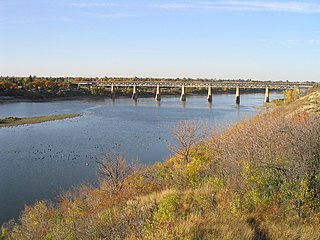
The Saskatchewan River is a major river in Canada. It stretches about 550 kilometres (340 mi) from where it is formed by the joining together of the North Saskatchewan River and South Saskatchewan River just east of Prince Albert, Saskatchewan, to Lake Winnipeg. It flows roughly eastward across Saskatchewan and Manitoba to empty into Lake Winnipeg. Through its tributaries the North Saskatchewan and South Saskatchewan, its watershed encompasses much of the prairie regions of Canada, stretching westward to the Rocky Mountains in Alberta and north-western Montana in the United States.

York Factory was a settlement and Hudson's Bay Company (HBC) factory located on the southwestern shore of Hudson Bay in northeastern Manitoba, Canada, at the mouth of the Hayes River, approximately 200 kilometres (120 mi) south-southeast of Churchill.
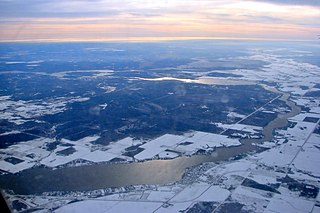
The Winnipeg River is a Canadian river that flows roughly northwest from Lake of the Woods in the province of Ontario to Lake Winnipeg in Manitoba. This river is 235 kilometres (146 mi) long from the Norman Dam in Kenora to its mouth at Lake Winnipeg. Its watershed is 106,500 square kilometres (41,100 sq mi) in area, mainly in Canada. About 29,000 square kilometres (11,000 sq mi) of the watershed is in northern Minnesota, United States.
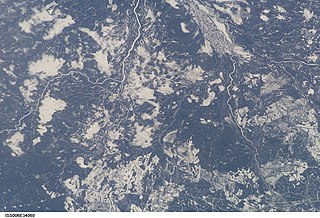
The Kenogami River is a river in the James Bay drainage basin in Thunder Bay and Cochrane districts in Northern Ontario, Canada, which flows north from Long Lake near Longlac to empty into the Albany River. The river is 320 kilometres (199 mi) in length and its name means "long water" in the Cree language. A portion of the river's headwaters have been diverted into the Lake Superior drainage basin.

The Petawawa River is a river in the Saint Lawrence River drainage basin in Nipissing District and Renfrew County in eastern and northeastern Ontario, Canada. The river flows from Algonquin Provincial Park to the Ottawa River at the town of Petawawa, and is only one of two major tributaries of the Ottawa River to flow completely free. The river's name comes from the Algonquian for "where one hears a noise like this", which refers to its many rapids.
The Fawn River is a river in the north of the Unorganized Part of Kenora District in Northwestern Ontario, Canada. It is in the Hudson Bay drainage basin and is a right tributary of the Severn River. The Severn/Fawn basin is one of the last few remaining undammed and unregulated watersheds south of the 55th parallel in North America.
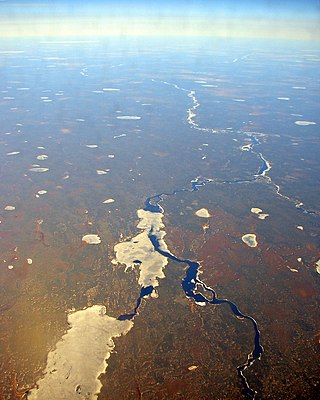
The Albany River is a river in Northern Ontario, Canada, which flows northeast from Lake St. Joseph in Northwestern Ontario and empties into James Bay. It is 982 kilometres (610 mi) long to the head of the Cat River, tying it with the Severn River for the title of longest river entirely in Ontario. Major tributaries include the Kenogami River and Ogoki River.

Little Grand Rapids is a community in east central Manitoba, Canada, near the Ontario border. It is located approximately 280 kilometers or 173 miles north-northeast from Winnipeg, Manitoba.
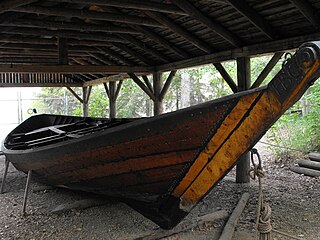
The York boat was a type of inland boat used by the Hudson's Bay Company to carry furs and trade goods along inland waterways in Rupert's Land, the watershed stretching from Hudson Bay to the eastern slopes of the Rocky Mountains. It was named after York Factory, the headquarters of the HBC, and by some accounts was supposedly modeled after the Orkney yole. Two variations to the York Boat were scows and "Sturgeon Heads."
The Berens River is a river in the provinces of Manitoba and Ontario, Canada. It flows west from an unnamed lake in Kenora District, Ontario, and discharges its waters into Lake Winnipeg near the community and First Nation of Berens River, Manitoba. The river has a number of lakes along its course, and many rapids.
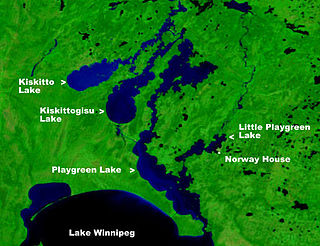
Playgreen Lake or Play Green Lake, is a lake in the province of Manitoba in Canada. The lake covers an area of 657 km2 (254 sq mi) and it is a part of the Nelson River watershed. The lake is the ninth largest lake in the province. It is located along the Nelson River some 10 kilometres (6.2 mi) north from the north end of Lake Winnipeg. It was first mapped by noted British surveyor, map-maker, chief fur trader and the explorer Peter Fidler in 1809.

The York Factory Express, usually called "the Express" and also the Columbia Express and the Communication, was a 19th-century fur brigade operated by the Hudson's Bay Company (HBC). Roughly 4,200 kilometres (2,600 mi) in length, it was the main overland connection between HBC headquarters at York Factory and the principal depot of the Columbia Department, Fort Vancouver.
The Bolton River is a river in the Hudson Bay drainage basin in Census Division No. 22 - Thompson-North Central, Northern Region, Manitoba, Canada. It is about 115 kilometres (71 mi) long and begins at Musketasonan Lake, about 20 kilometres (12 mi) south of Molson Lake, at an elevation of 249 metres (817 ft). It flows northeast through Little Bolton Lake at an elevation of 224 metres (735 ft), Rushforth Lake at an elevation of 218 metres (715 ft), Bolton Lake at an elevation of 212 metres (696 ft), where it takes in the right tributary Nikik River, and Kakwusis Lake at an elevation of 208 metres (682 ft). The river continues northeast over the twin Kasukwapiskechewak Rapids, then over the twin Kakwu Rapids, and empties into Aswapiswanan Lake at an elevation of 186 metres (610 ft), about 60 kilometres (37 mi) west southwest of the community of Gods Lake Narrows. The Bolton River's waters eventually flow into Gods Lake, and via the Gods River and the Hayes River into Hudson Bay.

The Frederick House River is a river in the James Bay and Moose River drainage basins in Cochrane District in northeastern Ontario, Canada. It flows 100 kilometres (62 mi) from Night Hawk Lake in the city of Timmins to its mouth at the Abitibi River in Cochrane, Unorganized, North Part. Both the river and the associated Hudson's Bay Company Frederick House post (1785–1821) are named for Prince Frederick, Duke of York and Albany, son of George III of the United Kingdom,

This article covers the water based Canadian canoe routes used by early explorers of Canada with special emphasis on the fur trade.
The Echimamish River is a river bifurcation in Manitoba, Canada. Located 70 kilometres (43 mi) northeast of the northern tip of Lake Winnipeg, it is about 60 kilometres (37 mi) long and runs east–west between the Hayes River and the Nelson River. It flows through nearly flat swampy country and has a barely detectable current. Flowing through peat bogs, the water acquires a dark color, hence the old name of Blackwater Creek. Since it is shallow canoe navigation is helped by beaver ponds. Morse claims that it flows in two directions from a central beaver pond. On the Echimamish is the Painted Stone Portage. This is not the divide between the two river basins, but a short carry around a shallow and rocky section. The only other obstacles are beaver dams.
Knee Lake is part of the Hayes River in Manitoba, Canada. It was on the voyageur route from York Factory on Hudson Bay to Norway House, Manitoba on Lake Winnipeg. It gets its name from a knee-like bend in the middle. The upstream western part is about 6 miles from south to north and less than 4 miles broad. The lake narrows to less than half a mile and then extends about 20 miles northeast, this section being at most 4 miles across. Near the knee is Magnetic Island with an ore body that is said to make compasses useless. Upstream from the lake, the Hayes River exits eastward out of Oxford Lake, goes over Trout Falls and widens into a long lake which joins Knee Lake at its southwest corner. The river exits the northeast end of the lake and after about 7 miles and four portages broadens into Swampy Lake. At the east end of Swampy Lake is the dramstone where west-bound voyageurs took a dram to celebrate leaving the most difficult part of the river.
The Fox River is a river in northern Manitoba, Canada. It flows east-northeast parallel to and between the Nelson River to the north and the Hayes River to the south. It joins the Hayes about 121 kilometres (75 mi) southeast of its mouth on Hudson Bay. About 121 kilometres (75 mi) above its juncture with the Hayes it splits with the southern branch being the Bigstone River. At the head of the Bigstone is Utik or Deer Lake from which it is possible to cross to Cross Lake on the Nelson. This route was part of the "Middle Tract" used by smaller Indian canoes to bring furs to the Hudson's Bay Company posts of Hudson Bay.
Fur trading on the Assiniboine River and the general area west of Lake Winnipeg, in what is now Manitoba, Canada, began as early as 1731.















